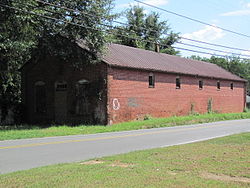
Rockingham is a city in Richmond County, North Carolina, United States, named after the Marquess of Rockingham. The population was 9,243 at the 2020 census. It is the county seat of Richmond County.

Bynum is an unincorporated community in northeastern Chatham County, North Carolina, United States on the banks of the Haw River. Bynum is five miles (8.0 km) north of Pittsboro and eleven miles (18 km) south of Chapel Hill. It is also known as Bynum Mill Village or Bynum Mill Hill.

College Hill is a neighborhood in the west central section of the United States city of Greensboro, North Carolina. College Hill was Greensboro's first neighborhood.

Henry River Mill Village is a small textile village in Burke County, North Carolina. It is an unaltered, but now-decaying example of an early industrial environment in Burke County. Today, the remaining buildings of the Henry River Mill Village are traces of the industrial heritage of the county.

Halifax Historic District is a national historic district located at Halifax, Halifax County, North Carolina, US that was listed on the National Register of Historic Places in 1970. It includes several buildings that are individually listed on the National Register. Halifax was the site of the signing of the Halifax Resolves on April 12, 1776, a set of resolutions of the North Carolina Provincial Congress which led to the United States Declaration of Independence gaining the support of North Carolina's delegates to the Second Continental Congress in that year.

Buffalo Mill Historic District is a national historic district located at Buffalo, Union County, South Carolina. The district encompasses 190 contributing buildings and 2 contributing structures associated with the Buffalo Mill textile mill complex and mill village. The mill complex includes the main mill, mill office, power house, ice factory, mill warehouse, company store, and company bank/drug store. The main mill building features applied stylized Romanesque Revival detailing. The mill village housing varies from large, free-classic, Queen Anne style supervisor's houses, to shingle-style bungalows, to simple, one-story, workers residences. The village also includes a school and a baseball field/park.

Glencoe Mill Village Historic District is a national historic district located at Glencoe, Alamance County, North Carolina. It encompasses 48 contributing buildings and 6 contributing structures built between 1880 and 1882 in Glencoe.
Lansing Historic District is a national historic district located at Lansing, Ashe County, North Carolina. The district encompasses 62 contributing buildings in the town of Lansing. The district includes commercial, residential, and institutional buildings dating to the early- to mid-20th century. Notable buildings include the Bank of Lansing, French Young Barber Shop Building, Sapp Department Store, Lansing Mill Company mill, Coble Dairy Plant, Lansing Presbyterian Church (1928), Lansing United Methodist Church (1944), French Young House, and Sapp House.

Garrou-Morganton Full-Fashioned Hosiery Mills, also known as Premier Hosiery Mills and Morgantown Hosiery Mills, is a historic hosiery mill complex located at Morganton, Burke County, North Carolina. The complex encompasses three contributing buildings and one contributing structure. They are the two Art Moderne style main buildings ; Outlet Store (1924) and Water Tower Structure.
Dunavant Cotton Manufacturing Company, also known as Alpine Cotton Mill No. 1, is a historic cotton mill located at Morganton, Burke County, North Carolina. It is a two-story, brick-clad, side gable-roofed building. The original section was built in 1888–1910, with additions and expansions through 1966. The additions to the building, made in the mid to late 1960s were removed in 2012 to reveal the original 1888-1910 mill building. It is the oldest cotton textile mill in Morganton, and was in use as a cotton textile mill until 1949.

Lenoir Downtown Historic District is a national historic district located at Lenoir, Caldwell County, North Carolina. The district includes 41 contributing buildings and 2 contributing objects in the central business district of Lenoir. It includes commercial, governmental, and institutional buildings in a variety of popular architectural styles including Art Deco, Art Moderne, Classical Revival and Tudor Revival. Notable contributing resources include the Center Theater (1941), O. P. Lutz Furniture Company and Lutz Hosiery Mill (1939), Dayvault's Drug Store (1937), Caldwell County Agricultural Building (1937), Courtney Warehouse, Masonic Hall, Miller Building, Confederate Monument (1910), Belk's Department Store (1928), Lenoir Building (1907), J. C. Penney Department Store, Fidelity Building (1928), and U. S. Post Office (1931). Located in the district is the separately listed Caldwell County Courthouse.
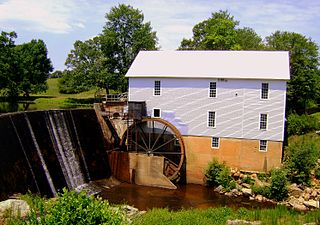
Murray's Mill Historic District is a national historic district located near Catawba, Catawba County, North Carolina. The district encompasses 20+ contributing buildings near the rural Town of Catawba. It contains the mill buildings, four residences and complementing structures associated with the milling operations and the Murray family. They were built between the 1880s and mid-20th century. Notable buildings include the large two-story frame mill (1912-1913), store building, wheathouse (1880s), John L. Murray House (1913), a large gable roof frame barn (1930s), Lloyd Murray House (1935), and William Murray House (1880s).
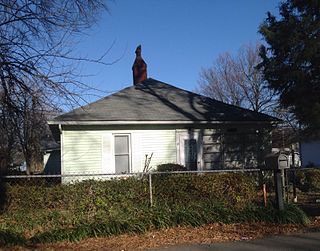
Margrace Mill Village Historic District is a national historic district located at Kings Mountain, Cleveland County, North Carolina. It encompasses 57 contributing buildings in a residential section of Kings Mountain. The houses date between about 1919 and 1956, and characterized by one-story frame mill houses. All of the principal resources in the district were erected by the Neisler family textile company and housed employees of the nearby Margrace and Patricia mills. Notable nonresidential buildings are the Margrace Mill Clubhouse and Margrace Mill Company Store.

Hope Mills Historic District is a national historic district located at Hope Mills, Cumberland County, North Carolina. It encompasses 61 contributing buildings and 3 contributing sites in the central business district of Hope Mills. Ii includes industrial, commercial, religious, and residential buildings and includes notable examples of Federal and Late Victorian style architecture. Notable buildings include the (former) Hope Mills Manufacturing Company buildings, Rockfish Manufacturing Company, Colin MacRae House, Christ Episcopal Church, Lebanon Masonic Lodge No. 391, and Alice L. Gilbert Store.

The Bessemer City Downtown Historic District is a national historic district in Bessemer City, Gaston County, North Carolina. It encompasses 23 contributing buildings and 10 contributing structures in Bessemer City's central business district. The buildings were built between after 1896, and include one- and two-story commercial buildings and two large, sprawling textile mill complexes. Notable buildings include:

Coleridge Historic District is a national historic district located at Coleridge, Randolph County, North Carolina. The district encompasses 17 contributing buildings in the Victorian mill village of Coleridge. It includes buildings built between 1882 and the late 1920s and notable examples of Queen Anne and Romanesque Revival architecture. Notable buildings include the Enterprise Cotton Mill complex, the company store, mill office, Bank of Coleridge, and John Caveness House.
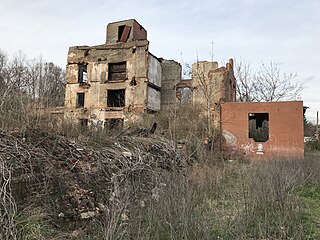
Franklinville Historic District is a national historic district located at Franklinville, Randolph County, North Carolina. The district encompasses 137 contributing buildings, 1 contributing site, and 5 contributing structures in the central business district and surrounding residential sections of Franklinville. It includes buildings built between about 1819 and the late 1920s and notable examples of Victorian and Greek Revival architecture. Notable buildings include the Franklinville Manufacturing Company complex, Johnson-Julian House, Horney-Curtis-Buie House, a group of antebellum mill houses, Madison Brower House, Hanks Lodge (1850), Frazier-Fentress House, Franklinville Methodist Church (1912-1913), Grove Hotel (1915-1919), and Franklinville Store Company (1920).
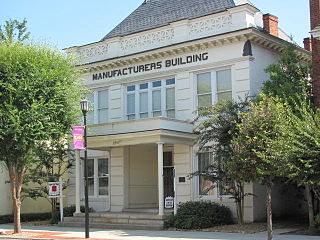
Manufacturers Building is a historic commercial building located at Rockingham, Richmond County, North Carolina. It was built about 1904, and is a two-story, cream-colored brick commercial building. Its brickwork is in common bond. It has a high hipped and slate covered roof. The building served as the administrative offices for five of the most important textile mills in Richmond County—Pee Dee Manufacturing Company, Steele's Mills, Roberdel Mills, Midway Mills, and Hannah Pickett Mills.

Rowland Main Street Historic District is a national historic district located at Rowland, Robeson County, North Carolina. The district encompasses 35 contributing buildings and 1 contributing structure in the central business district of Rowland. It includes buildings built between about 1891 to 1954 in a variety of popular architectural styles including Bungalow / American Craftsman. Notable buildings include the S.L. Adams Grocery and General Store (1891), Hedgepath and Chitty Clothing and Shoe Store (1905), Kheiralla Brothers Store, Rowland Drug Company (1902), Merchants and Farmers Bank (1911), Former Fire Station, and Rolling Milling Company. Six buildings have stamped metal fronts manufactured from galvanized sheet iron by the Chattanooga Roofing and Foundry Company.

The Waxhaw Historic District is a national historic district located at Waxhaw, Union County, North Carolina. It encompasses 93 contributing buildings, 3 contributing structures, and 1 contributing object in the central business district and surrounding residential sections of Waxhaw. The district developed between about 1888 and 1940 and includes notable examples of Commercial Style, Queen Anne, and Bungalow / American Craftsman style architecture. Notable buildings include the former Post Office (1905), Harris's store, Tyson Store, A.W. Heath Co. Mill (1905), R.J. Belk Company Store, A.W. Heath Company Stores, Weir Building, Plyler Building, Farmer's Ginning & Trading Company, McDonald Hotel (1912), Waxhaw Presbyterian Church (1929), Duncan McDonald House, and Ralph J. Belk House.
